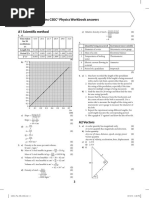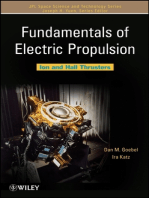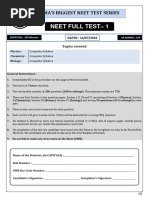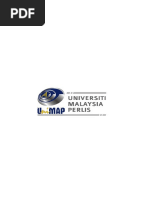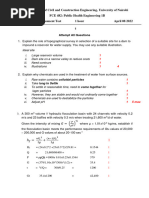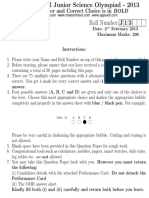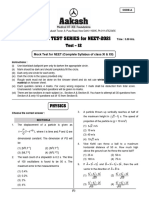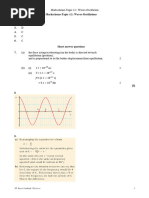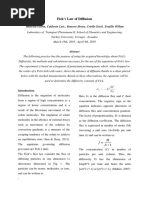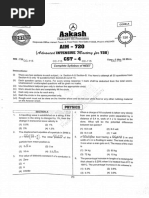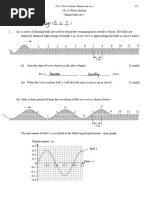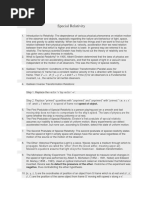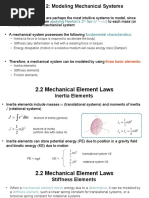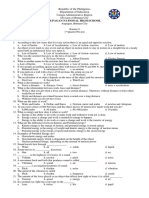Physics Workbook
Physics Workbook
Uploaded by
jaiden.shaw25Copyright:
Available Formats
Physics Workbook
Physics Workbook
Uploaded by
jaiden.shaw25Original Title
Copyright
Available Formats
Share this document
Did you find this document useful?
Is this content inappropriate?
Copyright:
Available Formats
Physics Workbook
Physics Workbook
Uploaded by
jaiden.shaw25Copyright:
Available Formats
Collins CSEC® Physics Workbook answers
A1 Scientific method density of steel
e) Relative density of steel = density of water (1)
1. a) 8000
= (1)
1000
Time taken 15.5 20.1 23.7 26.9 29.8 32.4 =8 (1)
for 20
3.
oscillations
t/s Quantity being measured Instrument most suitable
Length l/m 0.150 0.250 0.350 0.450 0.550 0.65 1 Diameter of a wire Micrometer screw guage
Period T/s 0.775 1.005 1.185 1.345 1.490 1.620 2 Mass of a coin Electronic balance
T /s
2 2
0.601 1.010 1.404 1.809 2.220 2.624 3 Temperature of boiling Thermometer
(6) water
2 2
b) T /s 4 Electric current flowing in Ammeter
3.0 a circuit
2.8
5 Period of a pendulum Stopwatch
2.6
2.4 (5)
2.2 4. a) 1. May have recorded the length of the pendulum
2.0 incorrectly, especially if the length is being measured
1.8 with a metre rule from a point other than zero. (1)
1.6 2. May have used the incorrect time for the period of
1.4 the swing of the pendulum, especially if the time
1.2 taken for multiple swings is being measured. (1)
1.0 b) 1. Find the time for 20 swings and then find the time
0.8 for one swing (period).
0.6
2. Ensure that the distance from the fixed point and
the centre of mass of the bob is measured. Use a
0.4
metre rule to measure the length of the string and a
0.2
micrometre screw gauge to measure the diameter of
0
0 0.1 0.2 0.3 0.4 0.5 0.6 0.7 the bob.
l/m 3. Repeat the experiment using different lengths. For
(10) each length measure the corresponding period.
c) Slope = change in T
2
(1) 4. Plot a graph of T 2 against l and draw the line of best fit.
change in l
2.4 − 0.4
Slope = (2)
0.6 − 0.1
= 4.0 s2/m (1) A2 Vectors
39.4 1. a) A scalar quantity has magnitude only. (1)
d) S=
g
A vector quantity has magnitude and direction. (2)
39.4
4= (1) b) Scalar quantity
g
4g = 39.4 Any one of: mass, distance, speed, energy, power (1)
39.4 Vector quantity
g= Any one of: velocity, acceleration, force, displacement (1)
4
g = 9.85 ms−2 (1) c) i) 4.3 N (1)
2. a) Density is the mass per unit volume. (2) ii) 2.5 N (1)
SI unit – kgm−3 (1) d) i)
b) Mass of 1 steel marble in grams = 336 = 33.6 g (1)
10
Mass of 1 steel marble in kg = 33.6 = 0.0336 kg (1) T
1000
c) Volume of 10 steel marbles = 92 – 50 = 42 cm3
42
Volume of 1 steel marble in cm3 = 10 = 4.2 cm3
W 90°
4.2
Volume of 1 steel marble in m3 = 1 × 106
= 4.2 × 10−6 m3 (2)
d) Density of steel = mass
(1) T (3)
volume
= 0.0336−6 (1)
4.2 × 10
= 8000 kgm−3 (1) 45°
CSEC_Phy_WB_ANS.indd 3 05/10/15 4:36 PM
ii) Using Pythagoras’ theorem (since one of the angles b) Extension/cm
in the triangle is 90°)
W 2 = 5002 + 5002 (1) 8.0
W 2 = 500000 (1)
W = √500000 = 707 N (1) 7.0
2. a)
6.0
5.0
nt
5N ulta
Res 4.0
3.0
60° θ 120°
2.0
O 6N
(4)
Resultant force = 9.5 N (1) 1.0
b) 27° (1)
0
0 0.2 0.4 0.6 0.8 1.0 1.2 1.4 1.6 1.8 2.0
A3 Statics Weight/N
1. a)
Fundamental quantity SI Unit Symbol
(10)
Mass kilogram kg change in extension
c) Slope = change in weight
(1)
Length metre m 8.3 − 0
= (1)
Time second s 2.5 − 0
= 3.32 cm N −1
(1)
Temperature Kelvin K d) spring constant = 1
(6) S
1
b) i) W=F×d (1) = (1)
3.32
=N×m = 0.301 Ncm −1
(1)
= Nm (1) e) i) Extension = 85.2 – 80 = 5.2 cm (1)
ii) Joule (1) From the graph, Weight = 1.3 N (1)
iii) P = F × d
W 1.3
Therefore, the mass = g = 10 = 0.13 kg (or 130 g)
t
ma × d (1)
= t ii) Weight = mg
= kgms−2 × ms−1 = 0.060 × 10 (1)
= kgm2s−3 (1) = 0.6 N (1)
iv) Watt (1) From the graph, the extension = 2.4 cm (1)
2. a) Moment of a force is the force multiplied by the
perpendicular distance from a fulcrum. (2)
SI Unit – Nm (1) A4 Dynamics
b) The sum of the clockwise moments about a point (1) 1. a) i) Velocity is the rate of change of displacement. ms−1
is equal to the sum of the anticlockwise moments (1) (2)
about the same point. (1) ii) Acceleration is the rate of change of velocity. ms−2
c) i) Sum clockwise moments = sum of anticlockwise (2)
moments (1) b) i) v/ms–1
(20 × 0.14) + (50 × 0.30) = X × 0.04 (1) 12
17.8 = 0.04 X (1)
X = 17.8
0.04
X = 445 N (1)
ii) Total upward force = total downward force (1)
445 = Y + 20 + 50 (1)
0 30 t/min (3)
Y = 445 – 20 – 50
change in velocity
Y = 375 N (1) ii) Deceleration = (1)
time taken
3. a) 12 – 0
= (30 × 60)
(1)
Mass/g 10 30 50 80 100 150 180 200
= 6.67 × 10−3 ms−2 (1)
Weight/N 0.1 0.3 0.5 0.8 1.0 1.5 1.8 2.0 iii) Distance travelled = area under the graph (1)
Extension/cm 0.4 1.2 2.0 3.2 4.0 6.0 7.2 8.0 = 1 × (30 × 60) × 12 (1)
2
(4) = 10,800 m (10.8 km) (1)
4
CSEC_Phy_WB_ANS.indd 4 05/10/15 4:36 PM
iv) F = ma (1) 5. a) Newton’s first law states that a body stays at rest or
= 3.0 × 107 × 6.67 × 10−3 (1) if moving continues to move with uniform velocity
= 2.0 × 105 N (1) unless acted upon by an external force. (2)
2. a) The rate of change of momentum is (1) Newton’s second law states that the rate of change of
proportional to the applied force (1) momentum is proportional to the applied force and
and takes place in the direction in which the takes place in the direction in which the force acts. (2)
force acts. (1) Newton’s third law states that if a body A exerts a force
b) A force is required for motion. (1) on body B, then body B exerts an equal and opposite
The velocity is proportional to the force. (1) force on body A. (2)
Increasing the force increases the velocity. (1) b) Mass is the amount of matter contained in a body
c) i) Aristotle, F = 0 (1) OR a measure of a body’s inertia. (1)
Newton, F = 0 (1) Weight is the force experienced by a mass when placed
ii) Aristotle, F is constant but not zero. (1) in a gravitational field. (1)
Newton, F = 0 (1) c) The Newton is defined as the force required to give a
iii) Aristotle, F is constant and now halved. (1) mass of 1kg an acceleration of 1 ms−2. (2)
Newton, F = 0 (1) d) i) Gravitational force due the Earth (1)
ii) The tension in the string (1)
3. a) i) Linear momentum is the product of a
iii) The friction between the tyres and the road (1)
body’s mass and velocity. (2)
e) i) In order to maintain circular motion (1)
ii) In a closed system (1)
an unbalanced force is required to provide the
the total momentum before a collision is equal (1)
acceleration. (1)
to the momentum after the collision. (1)
This force is provided by the gravitational force
b) Since both cars are at rest after the collision,
of attraction (1)
the total momentum = 0 (1)
by the Earth on the satellite. (1)
Both cars have the same mass and are travelling
ii) The Earth exerts a gravitational force on the
at the same speed in opposite directions.
satellite and (1)
Velocity is a vector quantity so (1)
the satellite exerts an equal (1)
total momentum before collision = mv + (− mv) = 0 (1)
but opposite force on the Earth. (1)
Therefore, the law of conservation of momentum
applies. (1) 6. a) Initial momentum = m × v (1)
c) Total momentum before collision = Total momentum = 0.01 × 12 (1)
after collision (1) = 0.12 kgms−1 (1)
(0.12 × V) + (4.5 × 0) = (0.12 + 4.5) × 4.2 (1) b) time taken to reach maximum height = (v – u) (1)
a
0.12 V = 19.40 (1) = (0 – 12) (1)
−10
V = 19.40 = 1.2 s (1)
0.12
V = 162 ms−1 (1) c) v/ms–1
4. a) i) Displacement is the distance moved in a stated 12
direction and is a vector quantity. (1)
Distance is a scalar quantity. (1)
ii) If a car starts at a point A and travels in a circular ↑
path a distance of 100m (1) 0 1.2 t/s
and returns to the point A (1)
the displacement will be zero. (1)
b) i) Acceleration = (v – u) (1) (3)
t d) Area under the graph between t = 0 and t = 1.2 s. (1)
= (20 – 0) (1) e) Maximum vertical height = 1 × 1.2 × 12 (1)
120 2
= 0.167 ms −2
(1) = 7.2 m (1)
ii) Force = m × a (1) 7. a) 2 ms–1 (1)
= 500 × 0.167 (1) b) v = u + at
= 83.5 N (1) = 0 + (10 × 3)
iii) Distance travelled = area under the graph = 30 ms−1 (1)
= 1 (20 × 120) + (20 × 380) + 1 (20 × 350)
2 2
= 12 300 (1) A5 Energy
Total distance travelled
iv) Average speed = (1) 1. a) i) Energy is the capacity to do work. (1)
total time taken
12300 ii) Energy can neither be created (1)
= 850
(1)
nor destroyed but (1)
= 14.5 ms−1 (1) can be converted from one form to another. (1)
v) Linear momentum = m × v (1) b) i) Electrical energy Light + Heat (3)
= 500 × 20 (1) ii) Potential energy Kinetic energy + Sound (3)
= 10,000 kgms−1 (1) iii) Chemical energy Kinetic energy + Heat (3)
5
CSEC_Phy_WB_ANS.indd 5 05/10/15 4:36 PM
c) i) Ep = mgh (1) iii) W = mg (1)
= 0.1 × 10 × 1.2 (1) = 240 × 10 (1)
= 1.2 J (1) = 2400 N (1)
ii) Loss in potential energy = gain in kinetic energy iv) Weight of oil drum = 2400 N (1)
(1) v) p = ρgh + atmospheric pressure (1)
1.2 = 1 × 0.1 × v 2 (1) = (1000 × 10 × 0.75) + 1 × 105 (1)
2
(2 × 1.2)
= 7500 + 1 × 105 (1)
v= √ 0.1 = 1.075 × 105 Pa (1)
v = 4.9 ms−1 (1) 4. a) m = ρV (1)
iii) W=F×d (1) = 1250 × (0.18 × 3.8 × 10−4) (1)
1.2 = F × 2 × 10−2 (1) = 8.55 × 10−2 kg (1)
F = 60 N (1) b) W = mg
2. a) i) Work is the force multiplied by the distance moved = 8.55 × 10−2 × 10 (1)
in the direction of the force. (1) = 0.855 N (1)
ii) Ep = mgh (1) c) mass of fluid displaced = ρV
= 120 × 10 × 0.8 (1) = 750 × (0.18 × 3.8 × 10−4) (1)
= 960 J (1) = 5.13 × 10−2 kg (1)
iii) W=F×d (1) Uphthrust = weight of fluid displaced (1)
= 200 × 8 (1) = 5.13 × 10−2 × 10
= 1600 J (1) = 0.513 N (1)
iv) Work is done against friction while the box is d) Reading on spring balance = 0.855 – 0.513 = 0.342 N (1)
moving up the ramp. (1) F
5. a) p = (1)
Energy is converted into heat and sound. (1) A
150
The gain in potential energy must therefore be less = 2 × 10−4
(1)
than the work done by the 200 N force, in order = 7.5 × 105 Pa (1)
for the law of conservation of energy to apply. (1) b) p = 7.5 × 105 Pa (1)
v) Efficiency = Useful output × 100 (1) c) F = p × A (1)
Input
960 = 7.5 × 105 × 3 × 10−4 (1)
= × 100 (1)
1600 = 225 N (1)
= 60 % (1)
B1 Nature of heat
A6 Hydrostatics 1. a) Heat was an invisible fluid called caloric. (1)
1. a) Pressure is the force acting normally per unit area. (2) Caloric could neither be created nor destroyed and
b) Pascal Pa (1) was present in all matter. (1)
c) Barometer, U-tube manometer, Bourdon gauge Temperature rises due to the addition of caloric. (1)
(Any 2) (2) Temperature falls due to the removal of caloric. (1)
d) W = mg (1) b) Lack of experimental evidence to show that a hot
= 55 × 10 body weighed more than a cold one. (1)
= 550 N (1) It was difficult to weigh a hot body accurately when
F
P=A (1) the temperature was changing. (1)
550 c) i) Horses were used to turn a blunt drill bit.
= (1)
2.2 × 10−3
= 2.5 × 10 Pa 5
(1) The drill bit was used to bore a brass cannon. (1)
2. a) p = ρgh (1) The brass cannon and the brass borings became
= 1150 × 10 × 45 (1) very hot. (1)
= 5.18 × 105 Pa (1) This heating effect continued as long as the
b) Total pressure = 5.18 × 105 + 100 × 103 (1) drilling continued. (1)
= 6.18 × 105 Pa (1) ii) Thermal energy can be created. (1)
3. a) A body wholly or partially submerged in a fluid Hence it is not a material substance. (1)
experiences an upthrust (1) Thermal energy is produced when work is done
which is equal to the weight of the fluid displaced. (1) against friction, as in the case of the drilling. (1)
b) i) Volume of water displaced = A × h (1)
= 0.32 × 0.75
= 0.24 m3
(1) B2 Macroscopic properties and
(1)
ii) ρ = m
V
phenomena
m=ρ×V (1) 1. a) Change in volume of a liquid
= 1000 × 0.24 (1) Change in volume of a gas
= 240 kg (1) Change in electrical resistance of a metal
Generation of an e.m.f.
Any two (1 mark each)
CSEC_Phy_WB_ANS.indd 6 05/10/15 4:36 PM
b) i) Temperature of pure melting ice (1) Heat the water and record several corresponding
Lower fixed point = 0 °C (1) values of the length of air column and temperature. (1)
ii) Temperature of steam above pure boiling water The pressure will remain constant provided that all
at normal atmospheric pressure (1) readings are taken at atmospheric pressure. (1)
Upper fixed point = 100 °C (1) c) Volume/cm3
c) Mercury is opaque. (1)
Mercury does not ‘wet’ glass. (1) 100
d) Can measure rapidly changing temperatures (1)
Can measure temperatures remotely (1) 90
2. a) Gas is made up of many small similar particles (1)
moving randomly at high speeds (1)
b) i) Molecules are moving randomly at high speeds. (1) 80
They collide with the walls of the container. (1)
They undergo a change in momentum and (1) 70
therefore exert a force on the walls of the
container. (1) 60
The force acts on the surface area of the inner
(
walls p = A
F
) (1)
50
ii) As the temperature increases the kinetic energy
of the molecules increases. (1)
They collide more frequently with the walls of 40
the container. (1)
There is greater change in momentum and
30
therefore a greater force is exerted on the walls
of the container. (1)
Therefore the pressure inside the container 20
increases. (1)
3. 10
Copper –300 –200 –100 0 100 200 300
Temp/°C (9)
d) From the graph volume = 28 cm3 (1)
e) From the graph temperature = −270 °C (1)
f) This is absolute zero. (1)
Heating element
Iron g) Gradient = change in volume (1)
change in temperature
95 − 5
The copper strip expands more than the iron strip when = 300 − (−240) (1)
heated by the heating element; (1) = 0.167 cm °C 3 −1
(2)
bi-metallic strip bends downwards; (1)
electrical circuit is broken; (1) 5. a) The pressure of a fixed mass of gas is inversely
when bi-metallic strip cools it returns to its original proportional to its volume provided that the
position. (1) temperature is kept constant. (2)
b) The pressure of a fixed mass of gas is directly
4. a) The volume of a fixed mass of gas is directly proportional to its absolute temperature provided the
proportional to its thermodynamic temperature, volume is constant. (2)
provided that the pressure is kept constant. (2) c) T1 = 27 + 273 = 300 K (1)
b) T2 = 67 + 273 = 340 K (1)
p1 = 190 kPa
p1 p2
T1
= T2 (1)
190 p2
Mercury Thermometer = 340 (1)
300
plug 340 × 190
p2 =
300
Air
p2 = 215 kPa (1)
Water d) T1 = 27 + 273 = 300 K
T2 = 67 + 273 = 340 K
p1 = 190 kPa
Heat
Set up the apparatus as shown above. (1) V1 = V
Record the length of the air column. (1) V2 = 1.05 V (1)
p1V1 p 2V2
Record the temperature of the water. (1) T1 = T2 (1)
CSEC_Phy_WB_ANS.indd 7 05/10/15 4:36 PM
190 × V
=
p 2 × 1.05V
(1) ii) E = mlf (1)
300 340 = 150 × 340 (1)
340 × 190 × V
1.05 p2V = (1) = 51000 J (1)
300
340 × 190 × V iii) E = mcΔT (1)
p2 = (1)
1.05V × 300
= 150 × 4.2 × 25 (1)
p2 = 205kPa (1)
= 15750 J (1)
iv) Total energy supplied = 3000 + 51000 + 15750
B3 Thermal measurements = 69750 J (1)
P=E
1. a) E = mlf (1) t
69750
= 0.08 × 3.4 × 105 (1) = 690
(1)
= 2.72 × 104 J (1) = 101 W (1)
b) E = mcΔT (1) 5. a) Ammeter, voltmeter, electric heater, power supply,
= 0.08 × 4.2 × 103 × (8 – 0) (1) oil, lagging, copper block, thermometer, variable
= 2.688 × 103 J (1) resistor (rheostat), stop watch (5)
c) Energy lost by lime juice = energy used to melt ice + b)
energy gained by melted ice
= 2.72 × 104 J + 2.688 × 103 J A
= 2.989 × 104 J (2) V
d) Energy lost by lime juice = mcΔT
2.989 × 104 = 0.32 × c × (29 – 8) Thermometer
2.989 × 10 4
c = 0.32 × 21
c = 4.45 × 103 Jkg−1 °C−1 (3) Heater Insulation
2. a) Energy per second = 850 × 4 Oil
= 3400 W (Js−1) (2) Copper
b) Energy absorbed by (3)
pot per second = 0.65 × 3400 = 2210 Js−1 (1) c) Energy supplied by the heater = IVt (1)
E=P×t (1) Energy gained by copper block = mc (T2 – T1) (1)
= 2210 × 40 × 60 Where
= 5.304 × 106 J (1) I – current flowing through heater
c) Energy = CΔT (1) V – potential difference across heater
= 8200 × 75 (1) t – duration of heating
= 6.15 × 105 J (1) m – mass of copper block
E
d) Efficiency = Eo × 100 (1) c – specific heat capacity of copper
1
6.15 × 105 T1 – initial temperature of copper block
= × 100 (1) T2 – final temperature of copper block
5.304 × 106
= 11.6 % (1) Energy supplied
3. a) Evaporation is the change in state of a liquid into a by heater = Energy gained by copper block
vapour without reaching its boiling point. (2) (assuming no heat losses) (1)
Boiling is the process by which a liquid changes into a IVt = mc (T2 – T1)
vapour at a particular temperature and pressure. (2) c = IVt (1)
b) Temperature is proportional to the average kinetic m(T2 − T1)
energy of all the molecules. (1) d) Insulate the copper block. (1)
The molecules with a high kinetic energy are able to Repeat the experiment by changing I but measuring
escape from the surface of the liquid. (1) the same temperature change. (1)
The average kinetic energy of the remaining 6. a) Ammeter, voltmeter, battery, heater, stop watch, ice,
molecules decreases. (1) beaker, retort stand, funnel (5)
Hence the temperature of the remaining liquid falls. (1) b) A
4. a) Specific heat capacity c, is the amount of energy
required to raise the temperature of 1 kg of a V
substance by 1 degree. (2)
Heat capacity C, is the amount of energy required to Heater Ice
raise the temperature of a substance by 1 degree. (2)
b) C = mc (1)
c) Latent heat of fusion is the amount of energy required
to change 1 kg of a solid into a liquid without a Water
(3)
change in temperature. (3) c) Energy supplied by the heater = IVt (1)
d) i) E = mcΔT (1) Energy gained by ice = mlf (1)
= 150 × 2.0 × 10 (1) Where
= 3000 J (1) I – current flowing through heater
V – potential difference across heater
CSEC_Phy_WB_ANS.indd 8 05/10/15 4:36 PM
t – duration of heating C1 Wave motion
m – mass of ice
lf – specific latent heat of fusion of ice 1. a) i) Wavelength is the distance between two successive
Energy supplied by heater = Energy used to melt points in phase OR (1)
the ice (1) The distance between two successive crests OR
IVt = m lf The distance between two successive troughs.
ii) Frequency is the number of cycles per second. (1)
lf = IVt (1)
m iii) Amplitude is the maximum displacement
from the equilibrium or rest position. (1)
B4 Transfer of thermal energy b) i) 0.8 cm (1)
ii) T = 0.4 s
1. a) Conduction, convection, radiation (3)
f= 1 (1)
b) Double walled glass with vacuum between – Heat lost T
by conduction and convection reduced (4) = 1 (1)
0.4
Silvered glass surfaces in vacuum – Heat lost by = 2.5 Hz (1)
radiation is reduced (2) iii) v = f λ (1)
2. a) Copper tubes – copper is a good conductor of heat. (1) = 2.5 × 1.5 × 10−2 (1)
Blackened surface – black surfaces are good absorbers = 3.75 × 10−2 ms−1 (1)
of heat. (1) 2. a) i) A progressive wave transmits energy from one
Glass – allows short-wave radiation to enter. The point to another. (2)
re-radiated long-wave radiation is trapped by glass. (1) ii) A transverse wave is one in which the particles in
b) Short-wave radiation easily penetrates the glass. (1) the wave oscillate at right angles to the direction of
The re-radiated waves have a longer wavelength and travel of the wave. (2)
cannot pass through glass. (1) iii) A longitudinal wave is one in which the particles
The radiation becomes trapped and the temperature in the wave oscillate parallel to the direction of
increases. (1) travel of the wave. (2)
c) CO2 is a greenhouse gas. (1) b) A progressive wave – water wave (1)
It behaves like the glass in the glasshouse effect. (1) A transverse wave – light (1)
More CO2 in the atmosphere causes global warming A longitudinal wave - sound (1)
and can lead to climate changes. (1) 3. a) Frequency = 1
T
3. a) Conduction is the flow of heat through matter from 1
=
a region of higher temperature to a region of lower (20 × 10−3)
temperature without the flow of matter as a whole. (2) = 50 Hz (3)
b) Convection is the flow of heat through a fluid from b) V = f × λ
a region of higher temperature to a region of lower = 50 × 4 × 10−2
temperature by the bulk movement of the fluid. (2) = 2 ms−1 (3)
c) Radiation is the flow of heat from a region of high
temperature to a region of low temperature by means
of electromagnetic waves. (2)
C2 Sound
4. a) Radiation (1) 1. a) Stand at one end of a long room. (1)
Vacuum exists between the Earth and the Sun, so (1) Measure the length of the room using a tape measure. (1)
conduction and convection cannot occur. (1) Using two blocks of wood, hit them to make
b) a sound. (1)
Record the time taken between hitting the blocks
Sea breeze
and hearing the echo using a stop watch. (1)
Land Speed of sound = (2 × length of room) (1)
v time
Sea b) λ = f (1)
= 340 (1)
250
= 1.36 m (1)
c) d = st (1)
In the day time, the land heats up faster than the sea. (1) = 340 × 9 (1)
Hot air rises above land. (1) = 3060 m (1)
Cooler heavier air rushes in from above the sea 2. a) In a sound wave the particles oscillate parallel to the
surface. (1) direction of travel of the wave. (2)
c) i) B (1) b) Pitch – frequency (1)
ii) Black surfaces are better absorbers than Loudness – amplitude (1)
shiny ones. (1) c) Light is a transverse wave/Sound is a
d) i) A (1) longitudinal wave. (1)
ii) Black surfaces emit radiation better than Light travels faster than sound in air. (1)
shiny ones. (1) Light can travel through a vacuum/Sound cannot. (1)
e) Good absorbers are also good emitters of radiation. (1) d) 20 Hz to 20 kHz (2)
CSEC_Phy_WB_ANS.indd 9 05/10/15 4:36 PM
3. a) Sound waves have a wavelength comparable to the Wide gap
width of the door; therefore sound waves diffract on
passing through the doorway and spread out into
the kitchen. Light waves have very much shorter
wavelengths, so no diffraction is observed and
the light waves travel in straight lines. (4)
b) i) Regions of sound and no sound (2)
ii) Interference (1)
iii) Waves from S1 and S2 interfere (1) (3)
Region of sound – two crests meet and d) The wavelength remains the same. (1)
constructive interference occurs (2) e) The wavelength is comparable to the width of
Region of no sound – a crest and a trough the gap (1)
meet and destructive interference occurs (2) 3. a) 1. The angle of incidence is equal to the angle of
4. Medicine – Ultrasound used obtain images of a baby refraction. (1)
in the womb of a woman (2) 2. The incident ray, the reflected ray and the normal
all lie in the same plane. (1)
Industry – Ultrasound is used to detect hairline b) O’
fractures in metals (2)
C3 Electromagnetic waves
1. a) Travel at 3.0 × 108 ms−1 (1)
Can travel in a vacuum (1) R1
Can be diffracted, reflected and interfere (1) R2
Consist of oscillating electric and magnetic fields (1)
b) Visible light, infrared radiation, microwaves (3)
v O (4)
c) λ = f (1)
4. a) Bending light as a result of change in speed
3 × 108
= 2 × 1010 (1) caused by travel in different media (2)
= 0.015 m b) Light travels between two media of different
= 1.5 cm (1) optical densities. (1)
d) The speed of light changes between the media. (1)
Electromagnetic Source Use
This causes the direction of light to change (bend). (1)
wave sin i
c) i) n = sin r (1)
infrared remote to control TVs,
radiation controls CD player 1.5 = sin 60° (1)
sin r
X-rays X-ray produce X-rays sin r = sin 60°
1.5
tube of bones sin r = 0.577
microwaves cellular communications r = 35° (1)
phone ii) n= 1 (1)
sin C
1
visible light sun photosynthesis 1.5 = (1)
sin C
(6) sin C = 1
1.5
sin C = 0.667
C4 Light waves C = 42° (1)
iii)
1. a) Newton – light is made up of particles (corpuscles) (1)
Huygens – Light is a wave (1) 60°
b) Wave theory (1)
c) Corpuscular theory (1)
2. a) Diffraction – the spreading of waves as they pass 35°
through a gap or past the edge of an object. (1)
b) Light has a very short wavelength. (1)
55°
Light casts sharp shadows. (1) 55°
c) Narrow gap
35°
Glass
Air 60°
(3) (4)
60°
10
CSEC_Phy_WB_ANS.indd 10 05/10/15 4:36 PM
5. a) i) Refractive index n = sin (angle of incidence) (2) sin r = 0.75
sin (angle of refraction) r = 48.6° (1)
ii) Critical angle is the angle of incidence for which e) Speed of light decreases from air to glass. (1)
the angle of refraction is 90° (1) This causes the ray to change direction. (1)
as a ray travels from a dense to a less dense f)
medium. (1)
iii) Total internal reflection occurs when the angle of Red
incidence is greater than the critical angle as a ray White Spectrum
light
travels from a dense to a less dense medium. (2) Violet
b) (3)
Glass
8. a) The refractive index = 1 where C is
sin C
Air the critical angle (1)
Total internal 1.33 = 1 (1)
Light ray sin C
reflection
sin C = 1
1.33
When a light ray enters one end of the glass, it strikes
sin C = 0.752
the inner walls of the glass. (1)
C = 48.8° (1)
The angle of incidence is greater than 42°. (1)
b) n = 1.33
Total internal reflection occurs and the light ray travels a w
through the glass. (1) n = 1 = 0.752 (1)
w a 1.33
c) Endoscope, periscope (2) n = sin i
w a sin r
sin 30 °
6. a) 0.752 = sin r (1)
sin 30 °
sin r = 0.752
Interference sin r = 0.665
pattern r = 41.7° (1)
Light
c) Air
source
42°
30°
Single 1 2 60° 60°
slit Double Screen
slit (5) 3 Water
b) Bright and dark fringes on a screen (1)
c) Bright fringe – constructive interference occurs (1)
Lamp (3)
– two crests meet (1)
– resultant amplitude is twice that
of either wave (1)
Dark fringe – destructive interference occurs (1)
C5 Lenses
– a crest and a trough meet (1) 1. a) Lens
– the resultant amplitude is zero (1)
d) Light spreads out beyond the double slits and causes Principle
the two sets of waves to overlap and interfere. (1) axis F F
v
7. a) n = v1 (1)
2
3.0 × 108 F – Focal point
= 1.9 × 108 (1) (4)
= 1.58 (1) b) Virtual (1)
v 1
b) f = λ (1) 2. a) =1+1 (1)
f u v
3.0 × 10 8
1 1
=
1.2 × 10−6
(1) = +1 (1)
f 12 4
= 2.5 × 10 Hz 14
(1) 1 1
v 1 λ1 =
c) =λ (1) f 3
v 2 2 f = 3 cm (1)
3.0 × 108 1.2 × 10−6
1.9 × 108
=
λ2
b) Magnification = v (1)
u
(1.9 × 108 × 1.2 × 10−6) 4
λ2 = (1) = (1)
3.0 × 108 12
λ2 = 7.6 × 10 m −7
(1) = 1 (1)
3
sin i
d) n =
a g sin r
(1) c) Height of image = magnification × object height (1)
1
1
= sin 30°
(1) = 3 × 2.5 (1)
1.5 sin r
sin r = sin 30° × 1.5 = 0.833 cm (1)
11
CSEC_Phy_WB_ANS.indd 11 05/10/15 4:36 PM
3. Converging (convex) lens d) i) B to A (1)
ii) Q = It (1)
= 4 × 10−6 × 2 × 10−3 (1)
Parallel = 8 × 10−9 C (1)
P F Principal
beams of iii) n = Q (1)
axis e
light 8 × 10−9
= (1)
1.6 × 10−19
f = 5 × 10 electrons
10
(1)
Principle axis – horizontal line passing through optical 2. a) The region around a charged body (1)
centre of lens (1) where an electric force is experienced (1)
b) i)
F – focal point (1)
f – focal length (1)
P – Optical centre (1)
+
4. a)
Scale
1 cm = 2 cm
(3)
F O F
ii)
−
i) image distance = 24 cm (1)
ii) height of image = 8 cm (1)
iii) magnification = v = 8 = 2 (1) (3)
u 4
b) A projector (1)
iii)
D1 Electrostatics + −
1. a) Friction causes electrons to flow from the cloth to the
polythene rod. (1)
The polythene rod has an excess of electrons. (1) (3)
The cloth loses electrons and become positively iv)
charged. (1)
b) Friction causes electrons to flow from the perspex rod + +
to the cloth. (1)
The cloth has an excess of electrons. (1)
The perspex rod loses electrons and becomes positively (3)
charged. (1) v)
+
c) Rubbing the pen charges it. (1)
The charged pen polarizes the molecules in
the paper. (1)
Electrons move away from one side of the paper to −
(3)
opposite end. (1) c) Hazard – electric shock/injury/death (1)
One end becomes positively charged and the other end Use – electrostatic spraying/photocopying/dust
becomes negatively charged. extraction (1)
The end of the pen closest to the paper attracts
the paper because it has a charge opposite to that
of the paper. (1) D2 Current electricity
Comb 1. a) A conductor conducts electricity. (1)
− An insulator does not conduct electricity. (1)
−
− − b) Conductors – iron nail, graphite rod (2)
−
− Insulators – plastic spoon, piece of rubber (2)
+
+ Paper
+ −
−
−
12
CSEC_Phy_WB_ANS.indd 12 05/10/15 4:36 PM
c) c) P = W (1)
t
9
= (1)
20
= 0.45 W (1)
d) Efficiency = ( Power output
Power input ) × 100 (1)
=( )
0.45
2.4
× 100 (1)
= 18.8 % (1)
3. a) Q = It (1)
(4) = 0.1 × 20 (1)
2. a) The flow of charge (1) =2C (1)
b) Coulomb (1) b) V = W (1)
Q
c) A copper wire – electrons (1)
= 240 (1)
A sodium chloride solution – sodium ions and 2
chloride ions (2) = 120 V (1)
3. a) Q = It (1)
= 2.5 × 10−3 × 2 × 60 (1)
= 0.3 C (1)
D4 Circuit components
b) n = Q (1) 1 a) Carbon rod
e
0.3
= (1)
1.6 × 10−19
= 1.88 × 1018 (1) Zinc can
4. a) Alternating currents reverse direction regularly
with time. (1)
Direct currents flow in one direction. (1) Ammonium chloride
b) i) Direct current (1) paste
ii) Direct current (1)
iii) Alternating current (1)
Manganese dioxide
5. a) Period: 20 ms (1)
and carbon
Peak value: 2.5A (1)
1
b) Frequency =
Period
Period = 2 × 10−2 (4)
f= 1 b)
T
1
= 120 V
20 × 10
−3
13 V Car battery
= 50 Hz (3) AC
(12 V)
(4)
c)
D3 Electrical quantities Zinc-carbon Lead-acid
1. a) Potential difference is the work done in primary cell battery
moving each unit of electrical charge across Terminal 1.5 V 12.0 V
the conductor V = ( W
Q ) (1) voltage
Maximum small large
per unit Coulomb of charge V = ( W
Q ) (1)
current
b) Volt (1)
c) P = IV (1) Internal high low
= 8 × 220 (1) resistance
= 1760 W (1) Portability small and light large and heavy
d) i) I = P (1)
V Rechargeability some can be can be recharged
= 650 (1) recharged
220
= 2.95 A (1) (10)
ii) E = P × t (1) 2. a) A
= 650 × 5 × 60 (1)
= 1.95 × 105 J (1)
2. a) P = IV (1)
= 0.4 × 6.0 (1) B
= 2.4 W (1) (3)
b) Ep = mgh (1) b) All the lights in string A will not light. (1)
= 0.60 × 10 × 1.5 (1) c) All the lights in string A will continue lighting. (1)
=9J (1) All the lights in string B will not light. (1)
13
CSEC_Phy_WB_ANS.indd 13 05/10/15 4:36 PM
3. a) V/V d) V = IR (1)
= 0.36 × 10 (1)
10.0 = 3.6 V (1)
e) VBC = 4.5 – 3.6 = 0.9 V (1)
9.0 I= V
R
= 0.9
8.0 5
= 0.18 A (1)
5. a) An ammeter is connected in series with the
7.0
component. (1)
It will affect the magnitude of the current being
6.0 measured. (1)
Its resistance must be as close to zero as possible. (1)
5.0 b) A voltmeter is connected in parallel with the
component. (1)
Current will flow through the voltmeter and affect
4.0
the potential difference being measured. (1)
Its resistance should therefore be very large. (1)
3.0 6. a) 1. Independent use of each appliance. (1)
2. If one appliance goes faulty, all the rest will
2.0 continue working. (1)
b) Live, neutral and ground (Earth) (3)
c) A fuse is connected to the live wire. (1)
1.0
An electrical fault may cause a large current to flow. (1)
The fuse blows and stops the current from flowing. (1)
0 d) The earth wire has a low resistance and allows a
0 2 4 6 8 10 12 14 16 18 20 I/mA (8) path of least resistance to the ground. (1)
∆V
b) Slope S = ∆I
(1) It is usually connected to the frame of the appliance.
= 9.8 − 0
(1) If a live wire touches the frame, a large current flows to
20 − 0 Earth and causes the fuse to blow. (1)
= 0.49 VmA−1 (1) P
Resistance of the conductor = 0.49 × 103 = 490 Ω (1) e) i) I = V (1)
c) = 1100 (1)
120
= 9.2 A (1)
A P
ii) I = V (1)
Conductor = 120 (1)
120
=1A (1)
iii) Electric iron – 10 A (1)
V (4) TV – 2A (1)
Steps f) Large currents can damage electrical components in
1. Set up the circuit diagram shown. appliances. (1)
2. Record the current I and the potential difference V. (1) Low currents can cause devices not to function as
3. Change the current flowing in the circuit by intended. (1)
adjusting the variable resistor. (1) Fluctuating currents can cause electrical fires in
4. Record the new current I and potential difference V. (1) appliances. (1)
5. Repeat steps 3 and 4 to obtain a series of readings. (1) 7. a) I I
1 1
4. a) = + 1 (1)
RT R1 R2
1
=1+1 (1)
RT 5 5
1 2 V V
= (1)
RT 5
RT = 5 = 2.5 Ω (1)
2
b) RT = R1 + R2 (1) Filament lamp Semi-conductor diode
(6)
= 10 + 2.5 (1) b) Resistance increases as current increases. (1)
= 12.5 Ω (1)
c) I = V (1)
R
4.5
= (1)
12.5
= 0.36 A (1)
14
CSEC_Phy_WB_ANS.indd 14 05/10/15 4:36 PM
D5 Electronics The alarm sounds when: (3)
1. The pressure is greater than 200 kPa, the temperature
1. a) is less than 500 °C and the flow rate is greater than
Logic Gate Symbol
103 m3s−1
Not
2. The temperature is greater than 500 °C, pressure is less
And than 200 kPa and the flow rate is greater than 103 m3s−1
Nor 3. The temperature is greater than 500 °C and the pressure
is greater than 200 kPa and the flow rate is greater than
b) AND Gate 103 m3s−1
A B 4. Electronic devices continue to get smaller as technology
advances. (1)
0 0 0 Logic gates and microprocessors are found in many
0 1 0 electronic devices (laptops, smart phones, washing
1 0 0 machine, toys). (1)
These electronic devices makes everyday tasks much
1 1 1 (3) easier (microwave cooking, washing, drying, cable
NOR Gate TV, Internet). (1)
Any reasonable attempt to explain the impact of advances in
A B
technology.
0 0 1
0 1 0
D6 Magnetism
1 0 0
1. a) A magnetic material is one that is attracted by a
1 1 1 (3) magnet. (1)
b) A non-magnetic material is one that is not affected
A B C D E by a magnet. (1)
0 0 0 1 1 b) The paper clip is metallic. (1)
0 1 0 0 0 When the magnet is brought close to the un-
magnetized material
1 0 0 1 1
the dipoles (tiny magnets) in the material align
1 1 1 0 1 (12) themselves. (1)
2. a) i) V Opposite poles attract (one end of a dipole and
A
one end of the magnet).
c) Permanent magnet – steel and magnadur (2)
Load t Temporary magnet – iron and mumetal (2)
B
(2) 2. a) The region around a magnet (1)
ii) V where a force is experienced. (1)
A b) The direction of the force acting (1)
Load on a North pole placed at that point in the field. (1)
t
c)
B
(2)
iii) V S N
A
Load t (2)
B
(2)
b) Both are direct currents (1)
S N S N
3.
A B C x y z
0 0 0 0 0 0 (2)
0 1 0 0 0 0
1 0 0 0 0 0
1 1 0 0 0 0 S N N S
0 0 1 0 0 0
0 1 1 0 1 1 (2)
1 0 1 1 0 1
1 1 1 1 1 1
(12)
15
CSEC_Phy_WB_ANS.indd 15 05/10/15 4:36 PM
D7 Electromagnetism d) I = V
R
(1)
1 a) 15
Soft iron core = (1)
5
=3A (1)
e) T = 1 (1)
f
= 1
20
= 0.05 s (1)
Primary coil Secondary coil V/V
(4) 15
b) Core is made of soft iron. (1)
Core is laminated. (1)
Coils are made of thick copper wires. (1)
0 0.025 0.05 t/s
c) The alternating current in the primary coil sets up
an alternating magnetic field. (1)
The secondary coil is situated in the changing −15
magnetic field. (1) (5)
According the Faraday’s law an e.m.f. is induced in f) Increase the speed of rotation of the coil (1)
the secondary coil. (1) Use more powerful magnets (1)
If the secondary coil is connected to a load, a current 3. a) i) Galvanometer needle deflects (1)
flows through it. (1) in a particular direction. (1)
Vp N
d) i) = Np (1) ii) Galvanometer needle returns to the zero
VS S
position. (1)
120
= 200 (1) iii) Galvanometer needle deflects (1)
1.2 × 103 NS
in the opposite direction. (1)
Ns = 200 × 1.2 × 10
3
120 b) i) Galvanometer needle stays at the zero
Ns = 2000 (1) position. (1)
ii) IpVp = IsVs (1) ii) Galvanometer needle deflects left and right
Ip × 120 = 0.4 × 31.2 × 103 (1) about the zero position. (1)
Ip = (0.4 × 1.2 × 10 ) iii) Galvanometer needle deflects left and right
120
Ip = 4 A (1) about the zero position (1)
iii) Transformers can step up and step down voltages but the magnitude of the deflection is greater
easily, but operate using AC. (1) than in b(ii). (1)
For a given power, if the transmission voltage is 4. a) A – split ring commutator (1)
high, the current can be low. (1) B – brushes (1)
This means that there are less power losses in the b) To allow for the current flowing in the coil to
transmission lines (P = I 2R). (1) reverse direction so that the coil moves in only
2. a) P – coil (1) one direction (1)
Q – brushes (1) c)
R – slip rings (1) b c
b) P
a
N S N S
d
R
B
Q
A
5Ω
(1)
(1) d) Current flows from a to b.
c) When the coil moves inside the magnetic field, there The wire ab experiences a downward force according
is relative motion between the conductor and to Fleming’s left-hand rule. (1)
the field. (1) Current flows from c to d.
An e.m.f is induced in the coil (Faraday’s law). (1) The wire cd experiences an upward force according
Since there is a closed circuit, a current flows through to Fleming’s left-hand rule. (1)
the resistor. (1) The forces acting on ab and cd produce a couple (1)
and cause the coil to rotate in an anticlockwise
direction. (1)
16
CSEC_Phy_WB_ANS.indd 16 05/10/15 4:36 PM
The inertia of the coil causes it to continue moving Observations
past the vertical position. (1) 1. Most of the alpha particles passed through the
The split ring commutator reverses the direction of gold foil. (1)
the current flowing in the coil and causes the coil 2. Some alpha particles were deflected. (1)
to rotate in one direction. (1) 3. Some alpha particles returned to the source. (1)
e) Any two from: Conclusion
1. Increase the current flowing through the coil (1) 1. Most of the atom is empty space. (1)
2. Increase the strength of the magnetic field (1) 2. The nucleus is very small and positively
3. Increase the number of turns of wire in the coil (1) charged. (1)
5. a)
E2 Structure of the atom
1. a) i) Atomic number is the number of protons inside
+ + + + + + + + + + + + + + + the nucleus of an atom. (1)
ii) Mass number is the total number of protons
(1)
and neutrons inside the nucleus. (1)
b) A – Insulation (1)
iii) Neutron number is the number of neutrons
B – Contacts (1)
inside the nucleus of an atom. (1)
C – Armature (1)
b)
D – Electromagnet (1) Particle Location Relative Relative
E – Coil (1) Mass Charge
c) When a current flows in the coil E (1) Electron orbiting the nucleus 1 −1
the electromagnet is energized. (1) 1840
The electromagnet pulls the armature C Proton inside the nucleus 1 +1
towards D. (1)
The contact B closes and (1) Neutron inside the nucleus 1 0
the secondary circuit is now closed. (1) (6)
6. a) The magnetism in an electromagnet can be turned c) Shell model shows the arrangement of electrons and
on and off. This is not so for a permanent magnet. (1) gives the exact position in the periodic table (period
b) Magnetic relay, electric bell etc. (1) and group) (1)
c) Increase the current flowing through the coil (1) d) i) Electrons – 6 (1)
Increase the number of turns used to make the Protons – 6 (1)
electromagnet (1) Neutrons – 8 (1)
ii) − −
E1 Models of the atom −
1. a) Plum pudding model (1) + +
+ −
+ Electrons
The atom is a positively charged sphere (1) +
+ −
−
in which electrons are distributed to make the atom
electrically neutral. (1)
b) Electrons orbit a positively charged nucleus (3) Proton
c)
Gold foil
Screen coated with
Neutrons (5)
zinc sulphide
e) i) Isotope – atoms of an element that have the same
atomic number (1)
Alpha but different mass number (1)
source Microscope ii)
Sodium-23 Sodium-24
Movable table Number of 11 11
Vacuum
electrons
Experiment is set up as shown in the diagram. (1)
Alpha particles are projected towards a thin sheet Number of 11 11
of gold foil. (1) protons
The alpha particles are viewed through a microscope. Number of 12 13
The slide/screen on the microscope is coated with neutrons
zinc sulphide. (1) (6)
25
An alpha particle is seen as a flash of light on the iii) 11Na (1)
screen.
17
CSEC_Phy_WB_ANS.indd 17 05/10/15 4:36 PM
E3 Radioactivity c) i) Number of half-lives = 24 = 3
8
(1)
1. a) 8000 4000 2000 1000 Bq (1)
Type of Nature of the Charge Stopped by Activity of sample after 3 half-lives = 1000Bq (1)
radiation radiation ii) 8000 4000 2000 1000 500 Bq (1)
Alpha- helium nuclei +2 a few cm of Elapsed time = 4 half-lives (1)
particle 2 protons and 2 paper Elapsed time = 4 × 8 = 32 days (1)
neutrons iii) Statement is incorrect. (1)
Radioactive decay is independent of factors
Beta- fast-moving −1 a few external to the nucleus, therefore heating has
particle electron mm of no effect. (1)
aluminium 3. a) E – energy (1)
Gamma electromagnetic 0 a few m – mass defect (1)
ray wave metres of c – speed of light (1)
concrete b) For:
(9) 1. More energy per gram than fossil fuel of
b) Alpha – short and thick tracks of equal length (3) equivalent mass (2)
Beta – thinner tracks of variable length (2) 2. Fossil fuels can be used for other purposes
c) i) Magnetic field (e.g. detergents/plastics etc.) (2)
Alpha Against:
Magnetic field 1. Disposal of radioactive waste material is
into the page challenging. It is dangerous to the
environment. (2)
Gamma 2. Risk of radioactive disasters/nuclear meltdown (2)
c) mass on left-hand side = 235.0439 + 1.0087
= 236.0526 u (1)
Radioactive
source
Beta mass on right-hand side = 89.9195 + 143.9230 +
(3)
(2 × 1.0087) = 235.8599 u (1)
ii) Electric field
mass defect = 236.0526 – 235.8599 = 0.1927 u (1)
mass defect in kg = 0.1927 × 1.66 × 10−27
Beta = 3.19882 × 10−28 kg (1)
Gamma E = mc 2
(1)
Alpha = 3.19882 × 10−28 × (3.0 × 108)2 (1)
Radioactive = 2.8789 × 10−11 J (1)
source 4. a) Use forceps to handle sample (1)
(3)
Always point sample away from body (1)
d) Paper GM tube
Sample should be kept in a sealed box when not
in use (1)
b) 50 25, t = 19 min (1)
40 20, t = 21 min (1)
Apparatus – GM tube, alpha source, beta source, 20 10, t = 20 min (1)
metre rule, sheets of paper, sheets of aluminium (1) Average half-life of sample B = (19 + 21 + 20)
3
Place source on a solid surface and place the GM = 20 min
tube in front of the source. (1) c) Radioactive decay is a random process. (1)
Place a metre rule between the source and the d) Sample A has a long half-life when compared to
GM tube. (1) sample B. (1)
Place a sheet of paper/sheet of aluminium between e) No change in graph (1)
the source and the GM tube and record the Radioactive decay is not unaffected by factors
variation in count rate. (1) external to the nucleus (1)
2. a) i) A radioisotope is an isotope of an element that is 5. a) 238 234 4
unstable and (1) 92U 90Th + 2He (2)
emits one or more of the following – alpha 228 224 4
particles, beta particles or gamma rays. (1)
b) 88Ra 86Rn + 2He (1)
ii) The half-life of a radioactive isotope is the 224 220 4
average time taken for the activity (or number 86Rn 84Po + 2He (1)
of atoms) to decrease by half its initial value. (2) 220 212 4
b) Radiotherapy – cancer treatment (1) 84Po 80Pb + 2 2He (1)
Tracers – detecting leaks/thyroid function (1)
212 212 0
Carbon dating (1) 80Pb 81Bi + −1e (1)
18
CSEC_Phy_WB_ANS.indd 18 05/10/15 4:36 PM
You might also like
- Full Download Vector Mechanics For Engineers 12th Edition Ferdinand Pierre Beer PDFDocument53 pagesFull Download Vector Mechanics For Engineers 12th Edition Ferdinand Pierre Beer PDFgilankmais80100% (3)
- Special Lab Report Simple Pendulum Length Variation FinalDocument9 pagesSpecial Lab Report Simple Pendulum Length Variation Finalapi-541796478No ratings yet
- Theory of Stellar Atmospheres: An Introduction to Astrophysical Non-equilibrium Quantitative Spectroscopic AnalysisFrom EverandTheory of Stellar Atmospheres: An Introduction to Astrophysical Non-equilibrium Quantitative Spectroscopic AnalysisNo ratings yet
- Collins CSEC® Physics Workbook Answers PDFDocument16 pagesCollins CSEC® Physics Workbook Answers PDFRa sa100% (3)
- Tutorial 4Document2 pagesTutorial 4Irfan Khan100% (1)
- Motion: Physical ScienceDocument2 pagesMotion: Physical ScienceHiyyih BaeNo ratings yet
- Neet Full Test - 1Document16 pagesNeet Full Test - 1ANUP MOHAPATRANo ratings yet
- Neet Full Test - 1Document16 pagesNeet Full Test - 1digvijay singhNo ratings yet
- Simple Harmonic Motion Experiment Using A PendulumDocument7 pagesSimple Harmonic Motion Experiment Using A PendulumWinston LeonardNo ratings yet
- HydroDocument23 pagesHydrojeanyencrysta montesaNo ratings yet
- Rigidity Modulus - Torsional PendulumDocument4 pagesRigidity Modulus - Torsional PendulumGAMES TECH0% (1)
- Experiment 8 - Ohms LawDocument3 pagesExperiment 8 - Ohms Lawarizhaiqal05No ratings yet
- Rubrik Pemarkahan Up1 2017 Sains Tingkatan 1: NO. SoalanDocument3 pagesRubrik Pemarkahan Up1 2017 Sains Tingkatan 1: NO. SoalanKhairul Fahmi Ab WahabNo ratings yet
- Final Jee-Main Examination - August, 2021: Physics Test Paper With SolutionDocument25 pagesFinal Jee-Main Examination - August, 2021: Physics Test Paper With SolutionFIESTA MUSICNo ratings yet
- Waterresourcesengineering I PDFDocument8 pagesWaterresourcesengineering I PDFhimabindugvsd71No ratings yet
- Lab1 Vibration MechanicsDocument5 pagesLab1 Vibration MechanicsdanaNo ratings yet
- The Period of Pendulum - Assessment - DarasDocument4 pagesThe Period of Pendulum - Assessment - Daraslegion maxxNo ratings yet
- FCE 482 CAT 2022 SolutionsDocument13 pagesFCE 482 CAT 2022 SolutionsnchekeenyagaNo ratings yet
- Pendulum Experiment (Fiver Work)Document3 pagesPendulum Experiment (Fiver Work)Shayan FarrukhNo ratings yet
- Pendulum Experiment: Trial Length of String (Centimeters) Time (Seconds)Document3 pagesPendulum Experiment: Trial Length of String (Centimeters) Time (Seconds)Shayan FarrukhNo ratings yet
- 66541b9dbf345d0018ac6997 - ## - Short Practice Test 02 - Test Paper - Arjuna JEE 2025Document3 pages66541b9dbf345d0018ac6997 - ## - Short Practice Test 02 - Test Paper - Arjuna JEE 2025adityashakwar3250No ratings yet
- Issues in Practical Problems, Part B: Turbulent FlowsDocument18 pagesIssues in Practical Problems, Part B: Turbulent FlowsSnehasish IsharNo ratings yet
- Max's AssignmnetDocument2 pagesMax's AssignmnetOCARE IVANNo ratings yet
- 05-02-2024 Even Batch Unit-1Document40 pages05-02-2024 Even Batch Unit-1fuckumotherfuckingdirtywhoreuglyasbitchNo ratings yet
- MAGNETISM AND MOVING CHARGES DDP6nnDocument3 pagesMAGNETISM AND MOVING CHARGES DDP6nnmonishbatmanabanNo ratings yet
- Pier Column REV.01Document20 pagesPier Column REV.01kalven marquezNo ratings yet
- Injso 2013Document22 pagesInjso 2013Aanchal MauryaNo ratings yet
- Assignment 02 Motion in a Straight Line Physics YAKEEN 2-0-2025Document9 pagesAssignment 02 Motion in a Straight Line Physics YAKEEN 2-0-202520150387587.prachiNo ratings yet
- Theme A Exam 1 MarkschemeDocument9 pagesTheme A Exam 1 MarkschemeadamfathialsalehNo ratings yet
- 5_6105186472418086671Document9 pages5_6105186472418086671anshutripathi8941No ratings yet
- Chapter 1Document4 pagesChapter 1Rozaini OthmanNo ratings yet
- Aakash FTS 12A (Only Eng)Document17 pagesAakash FTS 12A (Only Eng)evosgovind054No ratings yet
- T4_AnswerDocument14 pagesT4_AnswerTín Nguyễn TrọngNo ratings yet
- Fick's Law of Diffusion: Imaicela Gloria, Calderón Luis, Romero Henry, Criollo Erick, Trujillo WillamDocument5 pagesFick's Law of Diffusion: Imaicela Gloria, Calderón Luis, Romero Henry, Criollo Erick, Trujillo WillamLuis Calderon SalasNo ratings yet
- Bab 1: Pengenalan Kepada Fizik Bahagian A: Period Time For 10 OscillationsDocument19 pagesBab 1: Pengenalan Kepada Fizik Bahagian A: Period Time For 10 OscillationslapokNo ratings yet
- Intensive CST 4Document23 pagesIntensive CST 4chahalpuneet9No ratings yet
- Transmission Line Loading Sag CalculatioDocument25 pagesTransmission Line Loading Sag Calculatiooaktree2010No ratings yet
- Part Test 05 Questions Ranker NEET Test Series.pdf-CopyDocument18 pagesPart Test 05 Questions Ranker NEET Test Series.pdf-Copymistrysoumitra903No ratings yet
- Merryland High School (Physics) PDFDocument3 pagesMerryland High School (Physics) PDFVictor LusibaNo ratings yet
- P2 Memo June 2024-2Document5 pagesP2 Memo June 2024-2rinaemudau50No ratings yet
- Oct 2023 4Document1 pageOct 2023 4JunLi CaiNo ratings yet
- Physics Igcse 04 Jul 24 12 41 10Document12 pagesPhysics Igcse 04 Jul 24 12 41 10Johnson MangumaNo ratings yet
- SBP-answer PHYSICS P1 P2 P3-TRIAL SPM 2009Document15 pagesSBP-answer PHYSICS P1 P2 P3-TRIAL SPM 2009kamalharmoza100% (3)
- Chemical KineticsDocument11 pagesChemical KineticsrajaNo ratings yet
- Practice Problem 9Document3 pagesPractice Problem 9rajpootnishant02No ratings yet
- Physics Unit 1.1 SolvedDocument4 pagesPhysics Unit 1.1 SolvedAdn FarooqNo ratings yet
- Oscillation - Question Paper 04Document4 pagesOscillation - Question Paper 04Assadullah MemonNo ratings yet
- 6760425363440f6f3d6c39ae ## Practice Test-15 QuestionDocument23 pages6760425363440f6f3d6c39ae ## Practice Test-15 QuestionMohit Kumar GuptaNo ratings yet
- Atoms & Nuclear Radiation 3 MSDocument9 pagesAtoms & Nuclear Radiation 3 MSemily3brow8nNo ratings yet
- 6641ac80a2b050001860f747 - ## - Error + Unit and Dimensions - DPP 01 - Varun JEE Advanced 2024Document2 pages6641ac80a2b050001860f747 - ## - Error + Unit and Dimensions - DPP 01 - Varun JEE Advanced 2024officialniospracticalNo ratings yet
- 已編輯 - HW Ch 13 set 2Document4 pages已編輯 - HW Ch 13 set 2呆毛是本体No ratings yet
- Lab 5 Report Mass Moment of InertiaDocument18 pagesLab 5 Report Mass Moment of InertiaWasit JamalNo ratings yet
- FDN Eng-Part 2-04-09-2021-PrintDocument27 pagesFDN Eng-Part 2-04-09-2021-PrintShan SandaruwanNo ratings yet
- 2.5-Fizik-Skema-Kertas 3 Set ADocument9 pages2.5-Fizik-Skema-Kertas 3 Set AmurniNo ratings yet
- Chapter 6 P2Document22 pagesChapter 6 P2Arif Ahmad100% (1)
- Methods of Molecular Quantum Mechanics: An Introduction to Electronic Molecular StructureFrom EverandMethods of Molecular Quantum Mechanics: An Introduction to Electronic Molecular StructureNo ratings yet
- Tatva NLMDocument26 pagesTatva NLMJaishriramjaishrihanuman jaibajarangbalikiNo ratings yet
- Force and Motion - Session 01 - Newton's First LawDocument29 pagesForce and Motion - Session 01 - Newton's First LawJoyae ChavezNo ratings yet
- Answers: 1.1 Length and TimeDocument34 pagesAnswers: 1.1 Length and TimeL LHNo ratings yet
- Chemistry Class XI UT 2024-25Document3 pagesChemistry Class XI UT 2024-25i73566025No ratings yet
- AQA A-Level Applied Physics Chapter 1 Rotational DynamicsDocument21 pagesAQA A-Level Applied Physics Chapter 1 Rotational DynamicsJ3TL10% (1)
- Science 8 Module 1Document13 pagesScience 8 Module 1FATE OREDIMO100% (1)
- Week Topic Content Learning Outcomes Completed Date (Reason If Can'T Achieved)Document19 pagesWeek Topic Content Learning Outcomes Completed Date (Reason If Can'T Achieved)dododolNo ratings yet
- Chapter 1 Hoist (Edited3)Document42 pagesChapter 1 Hoist (Edited3)Mohd Shahrom IsmailNo ratings yet
- Special Relativity: Speed of ObjectDocument6 pagesSpecial Relativity: Speed of ObjectTawhid ShajadNo ratings yet
- FIITJEE Paper For 9th ClassDocument21 pagesFIITJEE Paper For 9th ClassAnil Kumar Malladi50% (2)
- Science 8 1st Quarter Reviewer PDFDocument6 pagesScience 8 1st Quarter Reviewer PDFMelanie Trinidad100% (4)
- DB 2Document7 pagesDB 2api-414035660No ratings yet
- Chapter 2: Modeling Mechanical Systems: Applying Newton's 2 Law (F Ma) Fundamental CharacteristicsDocument29 pagesChapter 2: Modeling Mechanical Systems: Applying Newton's 2 Law (F Ma) Fundamental CharacteristicsMohammad BilalNo ratings yet
- GEAS EngineeringDocument162 pagesGEAS EngineeringJake GlobioNo ratings yet
- Subject: Science Grade Level: Grade 8 Objective: Understand The Law of Inertia and Its Applications in Daily LifeDocument7 pagesSubject: Science Grade Level: Grade 8 Objective: Understand The Law of Inertia and Its Applications in Daily LifeJovilyn Jaca JardielNo ratings yet
- Engineering Mechanics Lecture NotesDocument13 pagesEngineering Mechanics Lecture NotesChella GanesanNo ratings yet
- Inertial Calcul PDFDocument10 pagesInertial Calcul PDFatesarikNo ratings yet
- Moment of Inertia and Angular AccelerationDocument5 pagesMoment of Inertia and Angular AccelerationJose GalvanNo ratings yet
- FORCE AND MOTION NOTES Class 9thDocument11 pagesFORCE AND MOTION NOTES Class 9thk.jha271210No ratings yet
- Laws of Motion 2Document9 pagesLaws of Motion 2愛.NiniNo ratings yet
- Dynamics CompleteDocument67 pagesDynamics CompleteImama WaqasNo ratings yet
- Physics WorkbookDocument16 pagesPhysics Workbookjaiden.shaw25No ratings yet
- Pretest in Science 8Document2 pagesPretest in Science 8anon_298904132100% (1)
- 1st Periodical Test g8 2016 2Document4 pages1st Periodical Test g8 2016 2Lauro Albano Jr.No ratings yet
- First Periodic Test in Science 8 I. Multiple Choice: Department of EducationDocument3 pagesFirst Periodic Test in Science 8 I. Multiple Choice: Department of EducationRaymond Bugagao100% (1)
- Motion Characteristics For Circular MotionDocument101 pagesMotion Characteristics For Circular MotionMelvin CabonegroNo ratings yet
- Concepts and Developments in Physics - Module I - Sem 1Document49 pagesConcepts and Developments in Physics - Module I - Sem 1an.radhakrishnan1452No ratings yet
- Journal of Baltic Science Education, Vol. 20, No. 1, 2021Document165 pagesJournal of Baltic Science Education, Vol. 20, No. 1, 2021Scientia Socialis, Ltd.No ratings yet



